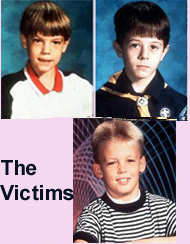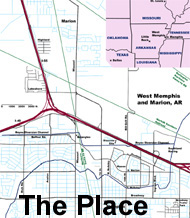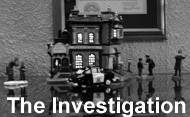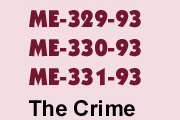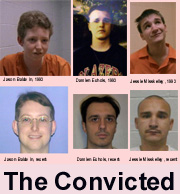Jivepuppi.com


Timeline
of the appearance of the evidence deemed significant by the jury in
determining the guilt of Jason Baldwin.
Blue entries represent major events in the case.
Red entries indicate when evidence was uncovered or reported,
not when it was presented to the defense.
A Twilight Kill, Part Eight:
Last Minute Evidence.
The investigation went wrong from the moment
of the
victims' discovery. The sensible inquiries were not performed. There
were no detailed statements from the employees of the nearby all-night
truck wash. For most of the parents, there was only the slimmest of
notes. Terry Hobbs said he was out searching all night and yet the
police did not ask him who or what he encountered. Most of the
neighbors nearest the victims' homes were not interviewed. Along with
the parents, they could have described suspicious persons in the area.
Instead the detectives collected thousands of pages
of rumors, stories by children and half-followed leads. As the months
passed while their clients awaited trial, the lawyers of the accused
were at a loss as to what sort of case the prosecution intended to
make. Their confusion was justified. The case wasn't in the documents
provided to them. In some instances, the evidence had yet to be found.
In other cases, it was only presented at trial.
The Echols/Baldwin jury made summary notes of their
deliberations and what factors went into deciding their verdict of
guilty. Baldwin's list was
- Damien's best
fried (sic)
- Low self-esteem
- Jailhouse
confession
- Fiber match
- Knife
- Frequented crime
scene
While
the
defense was aware that Baldwin was a friend of Echols, and how they
came to the conclusion of "low
self-esteem" is open to interpretation, the remainder of the list was
late in arriving.
Knife
In mid-November of 1993, over five months
after the
arrests, a long Rambo-style knife was found in the lake behind
Baldwin's trailer. The prosecutor claimed credit for the search, citing
a hunch. The knife wasn't introduced at the Misskelley trial,
Misskelley had made clear the weapon used was a folding knife. With
Misskelley recanting the confession and unwilling to attest to its
veracity, his statement couldn't be entered
into the Echols/Baldwin trial allowing the prosecutor freedom to
redefine the crime. Although the Rambo knife had no trace evidence on
it and nothing to associate it to Baldwin other than being in a lake
near his trailer, it was considered by the jury as evidence of his
guilt. It was not mentioned on Echols' list.
Was finding such a knife unrelated to the murders
near the Baldwin residence so improbable? Three knives were recovered
from the area near where the children were found and none was linked to
the crime. What could have been the source of the Lake Knife? One
possibility was Baldwin's neighbors. Anthony Hollingsworth and James
Ellison would later be registered as sex offenders, and, living two
doors down from the Baldwins, was John William Childers.
John W. Childers fled from his trailer home in North
Ft. Myers, Florida after murdering his common-law wife, Laure Catherine
Green, in November, 1983. Months later he appeared in Memphis and met a
Barbara Hay and moved in with her in the Lakeshore area.
America's Most Wanted ran several broadcasts
featuring him and his crime. A fifth broadcast in November 1993
(shortly before the lake was searched) led to a tip from a neighbor
dated November 16 stating that Childers lived "in West Memphis." The
newspaper accounts say he was brought to the police station where he
was questioned and fingerprinted. Before his prints could be correctly
matched, he skipped town. He was eventually arrested in Jacksonville,
Florida and sentenced to life in prison.
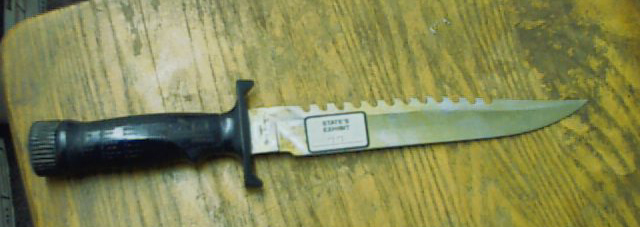
The "Lake" Knife
Fiber match
Individual strands of fibers were collected
from
the crime scene that were not similar to the victims' clothing. In
response
to this, ninety-two items of clothing and other fabrics were seized
during the execution of the search warrants. Along with the clothes of
the accused, these included a throw
rug, a cut out swatch of carpet, a blanket from the grandmother's
bedroom, a heating pad, the parent's housecoats, and clothes from
siblings.
Five sets of fibers, one to three strands each,
recovered from victims' clothes were determined to be microscopically
similar to fibers from items seized from the defendants' homes. None of
these came from clothing from the defendants, with the most prominent
ones coming from Baldwin's mother's robe and two different types of
fiber, cotton and polyester coming from Echols' young brother's size
six Garanimals shirt. All of the relevant fibers
were suggested to have been deposited by secondary transfer. For
example, the clothes Damien wore when he supposedly
committed the murders had picked
up both cotton and polyester fibers from a Garanimals
shirt in his home and then these fibers were transferred to several of
the items of clothing of the victims during the crime.
On December 20, 1993, six months after the accused
had been jailed, the authorities decided to test whether the fibers
could have been picked up at the victims' homes. A total of six items
were taken from two of their households. Two sets of fibers deemed
similar to clothing items from the accused were found to be also
similar to a shirt from the Moore's household. These same fibers
were further determined to be similar to those from a bag of clothes
found
at the crime scene. The size of clothes, pants with a tall 33 inch
inseam, did not
match any of the defendants.
Three more strands of fibers would be deemed similar
to items seized from the defendants' homes. These were found on a knife
belonging to a Jason Crosby.
Fogleman:
The reason I'm asking these questions the. . . this knife, the crime
lab says that knife has fibers on the that came out of Jason's house
and came out of Damien's house from some clothing of Damien's. [Jason
Crosby interview with prosecutor, September 2, 1993]
The prosecution made no attempt at trial to connect
Jason
Crosby or his knife to the defendants or to the crime. Nevertheless,
the presence of these fibers were used as an indication of guilt of the
accused.
The reports on the fibers including the controls
were filed in January, one month before the trials. The spectrographic
data indicating similarities was performed in February and March.
Officially, fibers can be described as being
microscopically similar and consistent from being from the same source,
but not as matching one another. Baldwin's attorney, Paul Ford,
attentively challenged a question a prosecution question that suggested
they match.
Prosecutor
Fogleman: Back on the red cotton fibers that you had originally
reported matched the garment from Damien Echols' home, which as a
result of further investigation you concluded that it also matched a
garment from the Moore's home. You can't say which home that came
from?
Ford: Your Honor, I
object
to the question because he keeps using the language 'matched.' She's
testified that they're not matches, but they're microscopically
similar. And I'd ask that he not indicate to the jury that they're
matches when that's not her testimony. [Sakevicius testimony,
Echols/Baldwin trial]
In contrast to this bit of diligence, the attorney
let pass many more references to fiber matches and even used the term
himself in a question. In the closing arguments, the prosecution
regularly referred to the items matching.
Davis:
... the only garment that was found in the searches of any of these
places that had a fiber that matched, and you've seen those graphs how
well it matches. . . [snip] But, those fibers match that
garment. [Prosecution closing argument, Echols/Baldwin
trial.]
Although ninety-two fabric items were seized during
the arrests and only six items came from two households of the victims,
Fogleman suggested a thorough search for exclusion had been performed.
Fogleman: You got Jason's
place search, you got Damien's place searched, you got
Jessie's searched, you've got the Byers house, you got fibers, and you
got fibers from the Moore house. And out of all those houses, out
of all the clothing in those houses, nothing. Nothing but this one
shirt were those fibers matched to. Ask yourself whether that
isn't significant. [Prosecution closing argument, Echols/Baldwin
trial.]
The jury agreed with the prosecution, citing fiber
matches as evidence of the guilt of Baldwin and Echols. One juror, in
separate notes, wrote "Fiber match - DNA."
Frequented crime scene.
Neither Baldwin nor Echols said they had
visited the
crime scene. No witnesses spoke at their trial placing them there. So
where does this peculiar assertion come from? Again, this was "late
evidence," it came from testimony at the trial. Echols testified about
walking around town. Living four and a half miles from Jason Baldwin
and not having cars,
he and Baldwin often made the trek on foot to visit each other.
Davis:
Had you been in the neighborhood near where Robin Hood Hills was in
that residential area -- had you and Jason walked in that neighborhood
on a frequent basis?
Echols: No. [Echols
testimony, Echols/Baldwin trial]
In the next day's testimony, Echols was asked,
Prosecutor
Davis: It is east of 14th Street and south of the Service Road
and the
Interstate. In that particular neighborhood, Market Street, Goodwin, in
there, did you and Jason frequently walk and roam in that area, the
same neighborhood where the three victims lived?
Echols: I think by
looking at the map I would have had to.
Davis: How often?
Echols: Probably in
that area, maybe twice a week.
Robin Hood Hills was west of 14th Street, with the
crime scene a quarter mile away. The jury believed they had caught
Echols in a lie. They also used this as evidence Baldwin had frequented
the crime scene.
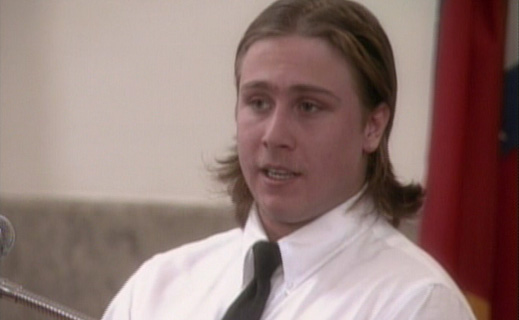
Michael Carson,
testifying at trial
Jailhouse confession.
The key piece of evidence against Jason
Baldwin was
the 16-year-old jailhouse snitch, Michael Carson. At the time Carson
first appeared to make his allegations, Baldwin had been in prison for
eight months.
On February 1, 1994, one month prior to the trials,
Carson came forward claiming to have overheard Baldwin confess during
Carson's September weeklong stay in juvenile lockup. Although Carson
made two contradictory statements, they were incorrectly treated as one
statement at the trial, and the notes from one was not allowed to be
compared to the transcript of the other.
By the time of the trials, Michael Carson had been
in and out of juvenile facilities for burglary and falsifying his
identity. He had completed at least two stays in mental health
facilities. He was diagnosed as having alcohol, hallucinogen and
marijuana dependency and polysubstance abuse.
His counsellor contacted Baldwin's defense attorneys
to warn them of his concerns that Carson would lie about his testimony
but was not permitted to testify. It was ruled his testimony would
violate the therapist/client privilege of a minor. Carson's history of
drug use was also excluded as evidence.
The alleged confession was brief. According to
Carson it came just after he had played a game of spades with two other
inmates and Jason and he were gathering up the cards before
lunch. "He told me how he dismembered the kids, or I don't
exactly how many kids. He just said he dismembered them. He sucked the
blood from the penis and scrotum and put the balls in his mouth."
[Carson testimony, Echols/Baldwin trial] Carson made no statement about
Echols' involvement.
Perhaps because Carson was a last minute witness,
Baldwin's attorney did little to discredit him, including performing no
investigation of Carson's incarceration. As part of Baldwin's recent
appeal, defense investigators have tracked down and "interviewed all
available staff or detainees who were in the facility with Baldwin and
Carson (a total of approximately 10 persons), none could corroborate
Carson's story. ...[The former unit supervisor] has reported that
she was actually told by law enforcement personnel to leave town at or
near the time that she might have been called as a witness for the
defense." [Writ of Error Coram Nobis, Charles Jason Baldwin,
filed May 29, 2008] Furthermore, when [the supervisor] was asked
to speak on the behalf of Baldwin during sentencing, she "was told by
the sheriff that she should not be in court." [Petition for Writ of
Habeas Corpus and Motion for New Trial, Jason Baldwin, May 30, 2008, p.
68] The supervisor and staff attested to closely monitoring Baldwin.
One said she would have noted if a "new person" interacted with
Baldwin. [ibid, p.70] One of the other members of the alleged card game
said he never played spades while incarcerated. [ibid, p.77]
The appeals describe Carson's history since the
trial. "Carson moved out of Arkansas, and lived in California where he
continued his involvement in criminal behavior according to his record
in California. He also allegedly continued to work for local law
enforcement agencies as an informant, and reportedly continued
fabricating information until he was discarded as an informant after
continuing to be arrested." [ibid, p. 84]
The jurors made summary notes of Carson's testimony
including, "nothing to gain," "extremely accurate" and "telling truth."
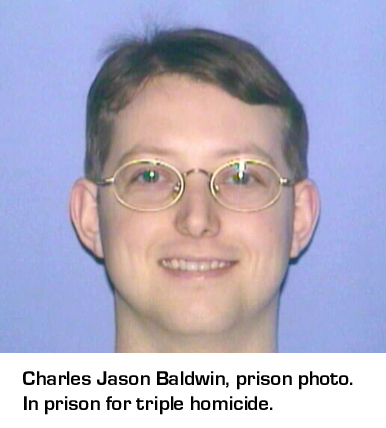
The Slicked Down Bank and The Pristine Meadow
Not only did witnesses appear at the last
moment,
the prosecution shaped its case with claims that were not supported by
any documentation. One problem the state needed to overcome was that
the woods behind the Blue Beacon had to be the murder site, rather than
a place where the bodies were dumped. Misskelley claimed the site was
where the attacks took place. Furthermore, the accused did not have
automobiles to bring the bodies to the site. The problem was, there was
no visible blood in this area - even though one of the victims was
determined to have bled to death.
The prosecution contended that the site where the
murders took place was a bank above where Moore was discovered and
where his recovered body was placed. They claimed the area was cleaned
of blood - along with leaves and twigs. The defense's response was the
same as when it was often caught off-guard - disbelief.
Fogleman:
Your Honor, the - let me get this photograph - Your Honor, the first 3,
which are 22, 23, and 26 are to show the condition of the bank. Uh -
they show the - how it's slicked off -
Defense attorney Paul Ford:
That is ridiculous.
Fogleman: - cleaned off, the
bank -
Ford: That's ridiculous.
[Ridge testimony, Echols/Baldwin trial]
Detective Ridge suggested the crime scene was
cleaned by hand.
Defense attorney Robin Wadley:
Scuff marks - you mean "slicked off," is that what you're saying?
Ridge: That's a term that could
be used, yes sir.
Wadley: Describe the scuff
marks.
Ridge: Looks as though somebody
may have taken their hands and rubbed the bank. [ibid]
No police notes were made describing this area as
being particularly cleaner than others. Moreover, this site was hardly
unique in having scuff marks, leaves missing and muddiness. The site
where the other two bodies were found was both scuffed up and absent of
leaves.
Another component of the theory that the woods was
the murder scene and not a dumping site was the geography. Bodies could
not be brought from the south because of the bayou channel. The west
was
bordered by the Blue Beacon Truck Wash - an all night establishment and
the only automobile described as passing there that night was that of
Mark Byers.
The northern border was the interstate. Finally, to the east, was a
meadow. Although the meadow could be accessed by a vehicle bringing the
driver near to the discovery site, the police were adamant that no
vehicles had passed there. In describing a grid search that took place
the day after the bodies were discovered, Detective Ridge emphasized
the pristine nature of the meadow.
Fogleman:
Detective Ridge, I want to go back to this grid pattern search that you
and the other officers did um - did you do an area besides the wooded
area?
Ridge: Yes sir.
Fogleman: Alright, and where
was that area located?
Ridge: Ok. This area between
the
field and the ditch, including part of that field and then this area
between this ditch and the field, and including part of that field.
Fogleman: Alright. And what
kind of field was that?
Ridge: A wheat field.
Fogleman: Alright. And uh -
what was the condition of the ground at that time when y'all did that
grid search?
Ridge: It was smooth, there was
grass, wheat growing in the area.
Fogleman: And uh - what if
anything did you find in the part of that field that you all searched?
Ridge: We didn't find anything,
it was normal, smooth.
Fogleman: Any automobile
tracks, truck tracks, anything like that?
Ridge: No sir. [ibid]
This observation became central to the prosecution's
summary of the case.
Fogleman:
Now also, they've tried to suggest that somehow this happened somewhere
else. [snip, as Fogleman described the geography and limitations as to
how the victims could have
been brought to the discovery scene.] Or, coming from the wheat field.
But officers walked that, remember they walked that field. They didn't
go the whole field, but over on the edge of the woods, they did their
arms length thing, where they walked from the ditch to the interstate.
No tracks, no vehicle tracks. [Fogleman closing argument,
Echols/Baldwin trial]
Again no police notes supported this claim, it was
brought to light at trial. The pristine meadow seems remarkable
considering the area was described as having been saturated by
searchers, including those using three-wheelers and
all-terrain-vehicles. Furthermore, it is directly contradicted by the
crime scene footage which shows a red vehicle parked in the meadow near
the discovery site.
Jason Baldwin was sentenced to life without the
possibility of parole. "When
Burnett asked each if there
were any reason the sentences should not be carried out, Baldwin said,
'Because I'm innocent.'" [March 20, 1994, Memphis Commercial Appeal]
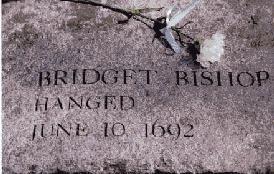
Salem,
Massachusetts.
Bridget Bishop tombstone.
Her last words were, "I am no witch.
I am innocent. I know nothing of
it."



